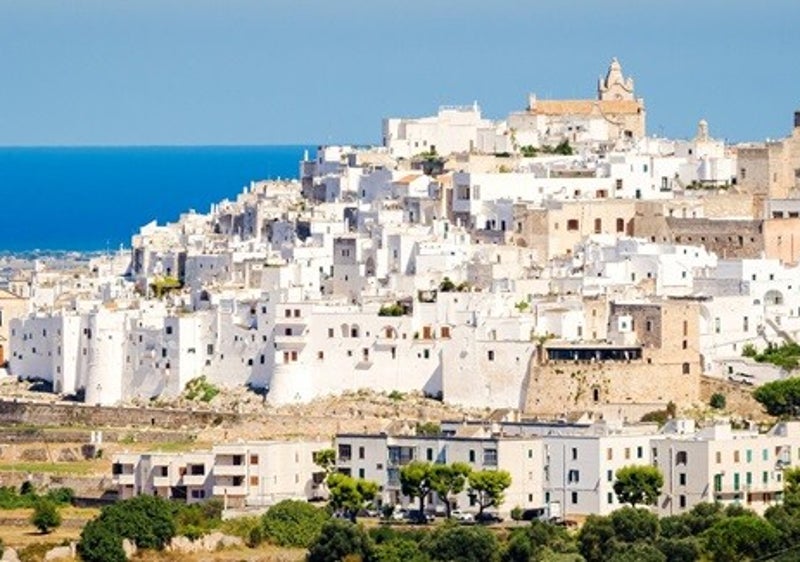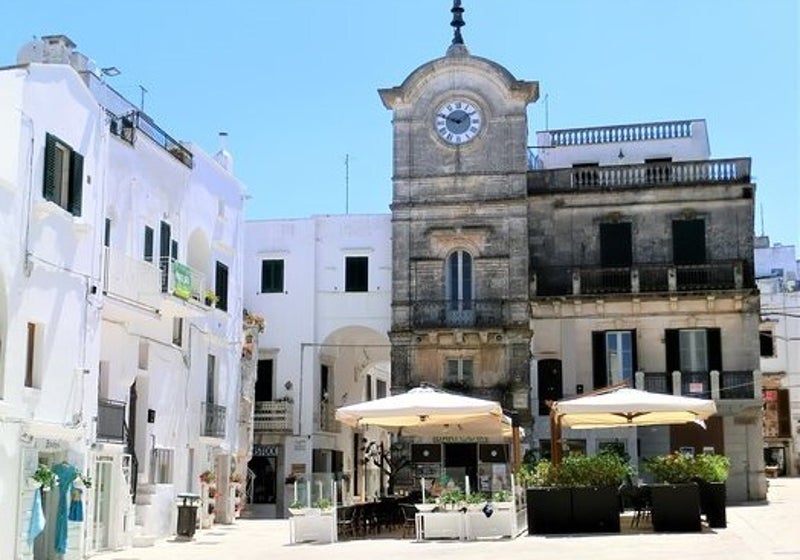sight seeing in brindisi province
Brindisi city has a lot to offer, but in our beautiful province you will also find many sights that can easily be visited from Brindisi. Either by public transport or by car.
famous apulian towns in the province of brindisi
mesagne

Mesagne is located about fifteen kilometers southwest from Brindisi. It stands out because of the abundance of Baroque, which you encounter on every street corner in the old part of the city. A walk through the historic center takes you past white houses, narrow streets, some quite impressive palazzi and a beautiful church with a cozy square.
Location
francavilla fontana

Located around 40 km southwest of Brindisi, this sleepy town is known for the the stunning castle and the numerous palatial mansions built by local aristocrats during the Baroque period. The most striking of these, the Palazzo Imperiale now houses municipal offices. Great place to wander or sit at a bar and watch the world go by.
Location
oria

The village of Oria, with its beautiful medieval piazzas, lanes, the Cathedral of Saint Mary of the Assumption and the elevated Norman Swabian castle. presents itself as a faithful guardian of good old traditions. The town is located on the highest hills of a hilly cordon of ancient fossil dunes in the north of Salento, giving it a dominant position on the surrounding plain. Distance from Brindisi city: 35 km.
Location
ceglie messapica

This a bit oriental looking town is located about 38 km west of Brindisi city. The houses are just as white and photogenic as in nearby Ostuni, but it is much less touristy here, making it more authentic.
The skyline is dominated by the dome of the cathedral and by the castle. It's not a place for grand monuments, but more for getting involved in everyday life in the many squares and narrow streets.
Location
san vito dei normanni

Just about 20 km from Brindisi city, the ancient town (1800 BC) of San Vito dei Normanni lies amidst olive groves and grape vines, near the Adriatic Sea. The tight web of streets hide baroque-style churches (e.g. Church of San Giovanni), palazzi, a park and a castle (called Castello Dentice or Castello di San Vito), along with excellent restaurants, caffes and pizzerias.
The Museo Diffuso of Castello d'Alceste is outside town, it's an open air museum and 6th century BC archeology site.
Location
carovigno

Carovigno is the most ancient village (1200 BC) in the region and its name derives from the Messapian word 'carbina' (derived from the Greek 'carpina' meaning 'fruitful'). It is situated about 30 km from Brindisi and is lesser-known .
It's a village where time seems to have stood still. It really has that authentic Apulian atmosphere with white houses, narrow alleys and its impressive castle Castello Dentice di Frasso. There are few tourists here, while it is ideally suited for a leisurely stroll. The small historic center is a maze of streets, stairs, dead-end alleys, arches and courtyards. Piazza Nzegna square forms the heart, with the austere facade and sixteenth-century bell tower of the Chiesa del Carmine. Down-hill you see modern neighborhoods sloping down to orchards full of centuries-old olive trees. Every now and then a tower rises into the sky between the olive trees. The fourteen towers in total were once used to transmit signals to the city from Torre Guaceto on the coast when danger threatened.
Location
ostuni - the white town

Ostuni, about 40 km North from Brindisi city is called La città Bianca. Residents are obliged to re-paint their house white every year - which from a distance gives the town a fairytale appearance. It is very popular and photogenic, which means it can be very crowded, especially in summer. There is also a variety of nice shops and stylish bars, pizzerias and restaurants. The cathedral at the top is worth a visit, but above all be enchanted by the white alleys where you can wander around . In the meantime, you can enjoy the beautiful views of the countryside and the sea in the distance.
CISTERNINO

This village about 60 km from Brindisi city has a small charming center with steep stairs, narrow shady streets and balconies full of colorful flowers. There is an elegant square with a particularly beautiful view over the Apulian countryside. In the landscape you will see groups of trulli and the characteristic small stone walls. A visit to the village is especially nice in the early evening, when the residents take their evening walk, on Piazza Vittorio Emanuele (with the Torre dell'Orologio). This village belongs to "borghi più belli d’Italia"; list of most beautiful villages in Italy.
Also view the seventeen-meter-high Torre di Porta Grande on the edge of the historic center, the foundations of which were once laid by the Normans. At the top of it is a small statue of San Nicola, Saint Nicholas. There is also a church dedicated to Saint Nicholas, with a particularly beautiful tabernacle with a Madonna statue.
fasano

Fasano about 60 km from Brindisi city is surrounded by lush countryside full of farms and trulli. Its sparkling white historic center is a quaint maze of narrow lanes, archways, stairways, and little piazzas. Piazza Ciaia is the social hotspot and is encircled by beautiful buildings; it's a favorite spot for a stroll and a gelato. Also check out the Baroque Arco dei Cavalieri (Arch of the Knights), the little alleyway of via del Balì and the Palazzo of the Knights of Malta, nowadays the town hall. The Museum of Olive Oil indicates the area's primary product.
characteristic apulian sights & archaeological findings
valle d'itria

The beautiful Itria Valley in the centre of Puglia spreads over the provinces of Brindisi, Bari and Taranto coinciding with the lower part of the Murgia upland. The valley stretches from Putignano in the north to Cisternino - Ostuni in the south. It has wooded slopes, vineyards and endless olive groves punctuated by the coned roofs of Trulli, the unique cylindrical constructions that are peculiar to the area. The walls of stacked stones that you see everywhere are on the UNESCO cultural heritage list, just like the truli at Alberobello.
archaeological museum egnazia
The very interesting National Archaeological Museum of Egnazia stands outside the walls of ancient Gnathia, in the area of a Messapian necropolis.
The exhibition traces the thirty centuries of history of the important settlement, from the Bronze Age to the Middle Ages. Visit the website for more information and location.
madonna d'ibernia

For the residents of the above mentioned town of Cisternino, this little Romanesque church dedicated to Madonna d'Ibernia, three kilometers outside the village, is very important. The nickname of this Madonna is 'Madonna of the eggs' because she ensures that there is enough to harvest. In the spring there are many prayers for a fruitful summer, with the villagers bringing chïrrùchele (a typical sweet from Cisternino) to the virgin to propitiate her.

